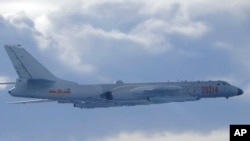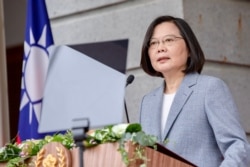China showed no sign of easing its military intimidation against Taiwan on Monday after reportedly flying another military transport aircraft near the airspace of the island, which it views as a renegade province.
Reports say the plane flew over Taiwan’s air defense identification zone, or ADIZ, but did not cross the so-called Taiwan Strait median line separating China from the self-ruling island. There has been no comment from Taiwan defense officials on the reported incursion.
China has recently increased military activity around Taiwan, including flying fighter jets across the boundary, which Taipei views as “a symbol of preventing military confrontations” with the mainland.
Although a Taiwan official has told the Chinese to “back off,” Beijing now says the line is non-existent as it views Taiwan as part of its territory. Beijing has not ruled out the use of force to unite the two sides.
Analysts warn that China’s repeated use of such crossings and military flyovers will only backfire while fueling unnecessary tension in the region.
“The Taiwan Strait median line is a stabilizing mechanism in the cross-Strait military relationship which the Mainland-side has unilaterally abrogated, significantly worsening the regional security situation,” said Drew Thompson, a visiting senior research fellow at the Lee Kuan Yew School of Public Policy at the National University of Singapore Monday, in a written reply to VOA.
The unofficial line, drawn in the 1950s reportedly by U.S. General Benjamin Davis to separate the two sides in conflict, has succeeded for decades in reducing the risk of accidents with the mainland and Taiwan sticking to their side of the strait.
But China’s foreign ministry spokesman, Wang Wenbin, recently said, “There’s no such median line in the Taiwan Strait,” after China’s military sent warplanes and bombers into the island’s airspace and across the median line in response to a visit to Taiwan earlier this month by U.S. Undersecretary of State Keith Krach. He was the highest-level U.S. official from the State Department to visit Taipei in decades.
As Taiwan has been self-ruled for seven decades and considers itself an independent sovereign state, its foreign minister, Joseph Wu, responded strongly by telling China to “back off and return to the civilized international standards.”
Calling Wang’s comments “equivalent to destroying the status quo,” Wu urged the international community to condemn what he called China’s “dangerous and provocative words and deeds threatening peace.”
Shen Dingli, an international relations professor at Shanghai’s Fudan University, defended China’s stance, saying that Beijing has never agreed on such a line and is not obligated to honor the boundary marked by the U.S.
Shen added that Beijing had no choice but to respond with the recent increase in military activity, which he said was meant to show its displeasure over Washington’s increased semi-official exchanges with Taiwan – a violation of the one-China principle.
A warning to the U.S.
“The Mainland had to send a warning: you [the U.S.] have repeatedly violated what you’d agreed [to China when establishing diplomatic ties]. We have no intention of engaging in a war with you. But we need to warn you: if you keep on doing what you’re doing, it will likely embolden Tsai Ing-wen and Taiwan’s pro-independence separatists, who may turn audacious to declare [de jure] independence,” Shen told VOA on Monday over the phone. Tsai is Taiwan’s president.
Under such circumstances, China will be entitled to “make the first strike” or resort to use of force so as to safeguard its national interest, Shen argued.
In a commentary last week, China’s state media Global Times stated that “the bogus median line is only a tacit understanding when cross-Straits relations were eased, and when Taiwan adhered to the one-China principle,” citing scholar Zhu Songling.
That suggests China wouldn’t honor the median line if the U.S. or Taiwan fails to respect its one-China principle. The principle holds that Taiwan is part of China and the Communist government in Beijing is China's sole legitimate government.
U.S. officials repeatedly have said the United States does not recognize Beijing’s version of the “one-China principle.”
Instead, its official “one-China policy” is that Taiwan’s status is undetermined. And the policy is intentionally ambiguous, leaving any final resolution of their differences up to the people of Taiwan and China. What the U.S. explicitly opposes is either side unilaterally changing the status quo or resorting to a non-peaceful resolution.
Will Taiwan follow suit?
With China now denying the existence of the median line, some argue that, for the sake of deterrence, Taiwan should consider following suit.
Others believe such a reciprocal response will do Taiwan no good and further fuel tension.
“This is a sort of brinksmanship at play here. Ultimately, it depends on how resolved both sides are in terms of their claims of sovereignty as well as their counterclaims of not having such sovereignty,” said Oh Ei Sun, a senior fellow with Singapore Institute of International Affairs.
Both Oh and Thompson agreed that China’s military provocation has long had little impact on intimidating the people of Taiwan.
“The people of Taiwan have lived under the shadow of a PRC (People’s Republic of China) attack for generations, so it is unlikely that increased PLA (People’s Liberation Army) Air Force patrols will alter strong public support for their own democracy or current public opinion which does not favor unification with an authoritarian Mainland China,” Thompson said.
In the face of China's military provocation, polls released last week showed that a record 86% of people in Taiwan identified themselves as Taiwanese instead of Chinese.










